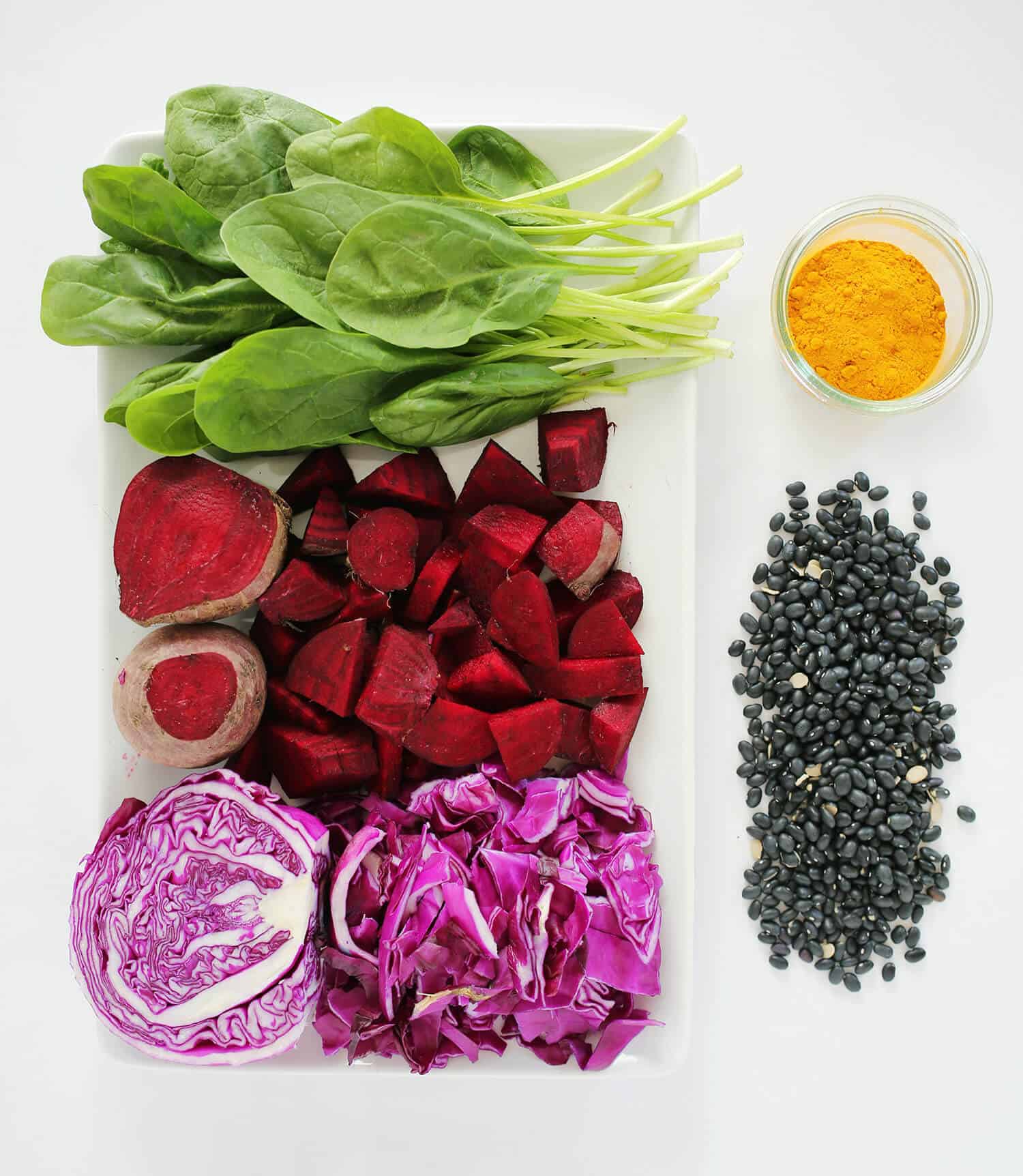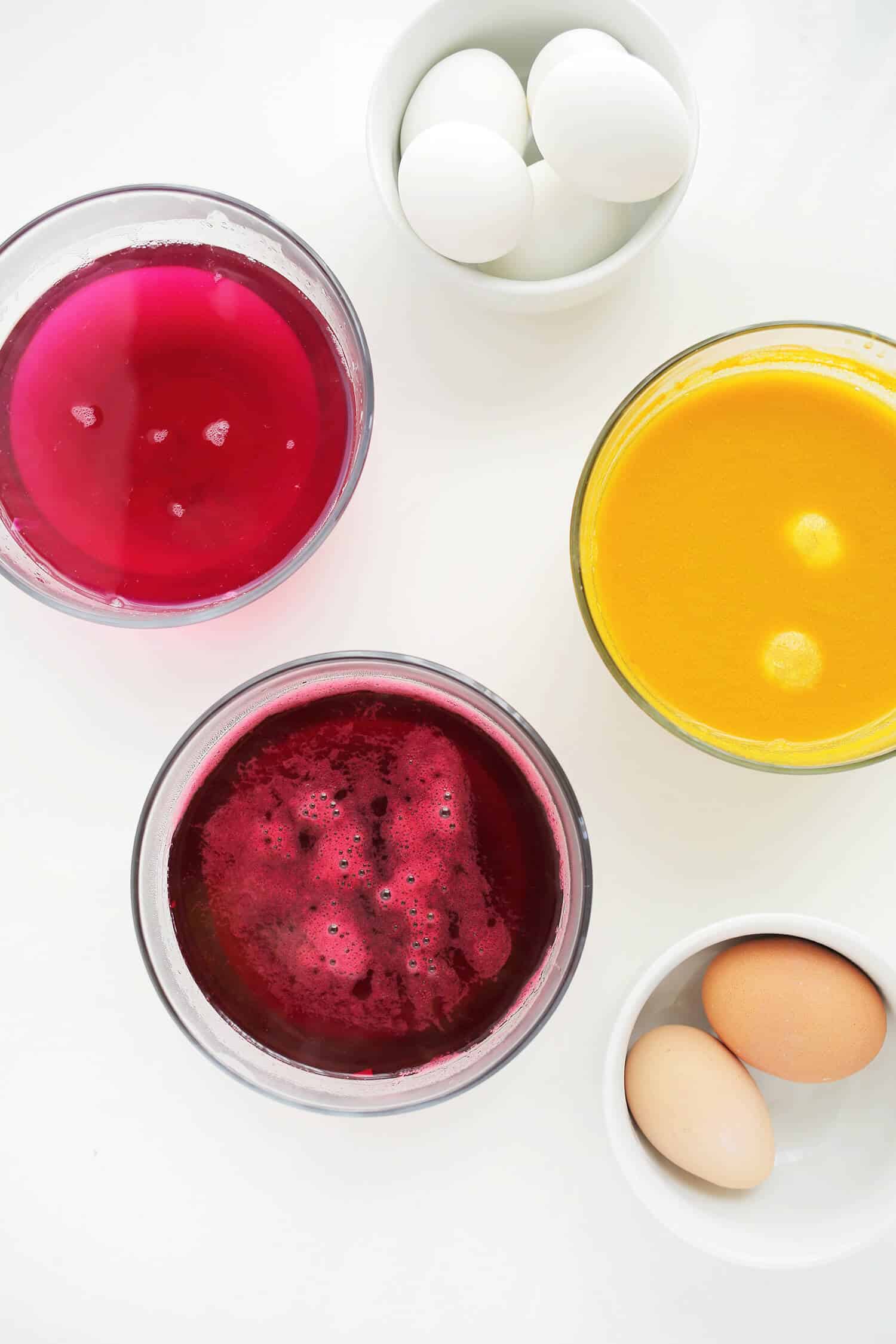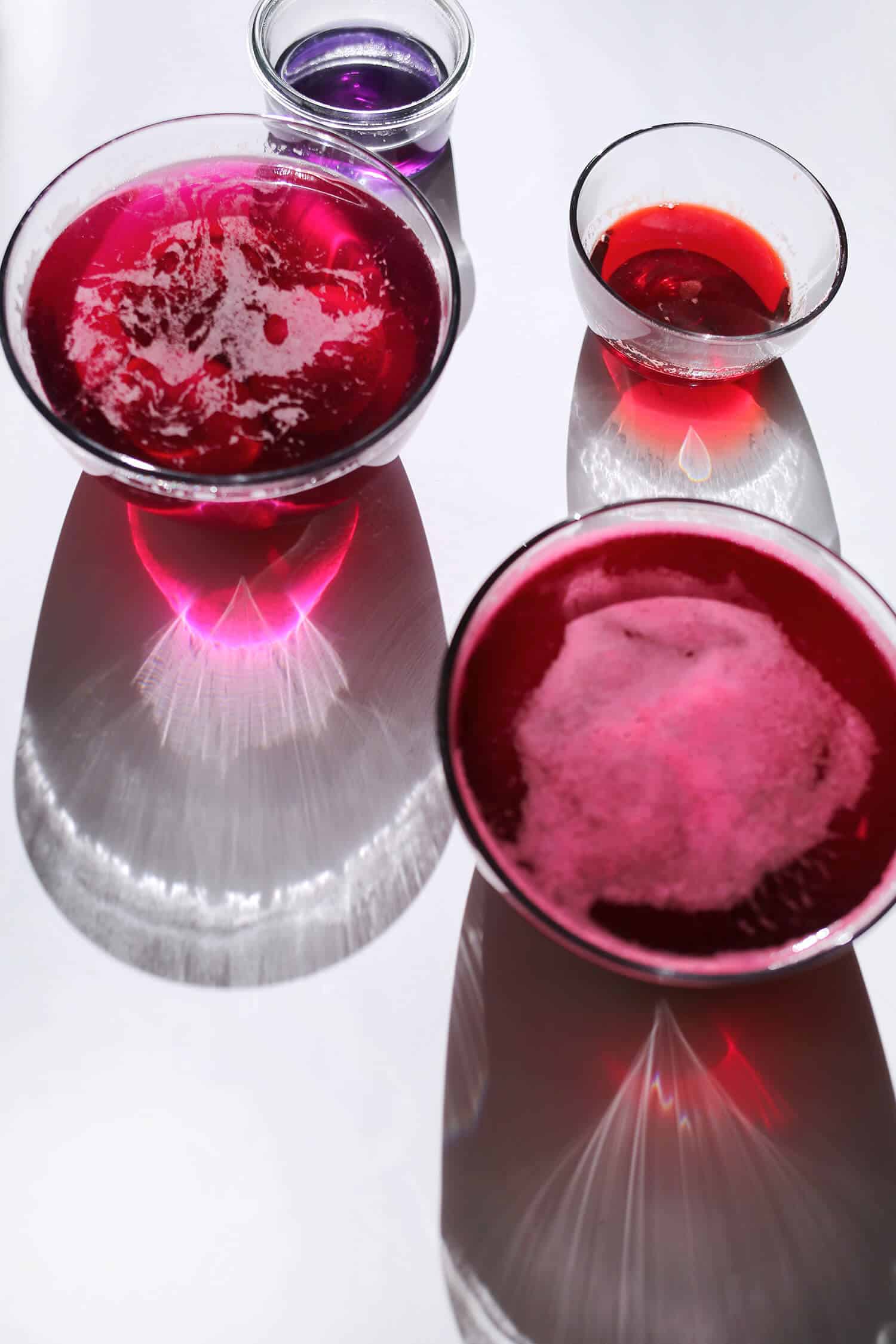
Related: How to dye Easter eggs without a kit on Childhoodmagic.com
If you’re wanting to try natural dyes this Easter because you want to skip the fake, processed dye tabs or maybe you are just as curious as I am about the magic of drawing color from plants, this is the tutorial for you! If you’re hoping it’ll be a tidy, quick process … well … we can all learn to slow it down a bit, right? Ha! It IS something your kids can help with and you can rest assured that your hard-boiled eggs can be snacked on or turned into egg salad leftovers because all items involved are natural and plant based!

-hard boiled eggs (white eggs allow brighter colors, brown allow warmer/darker colors)
-white vinegar
-5 medium beets
-one red cabbage
-1 pound raw spinach
-turmeric
-5 avocados
-small bag of dry black beans
-3-5 sauce pans depending on how many vegetables you are dyeing
-3-5 containers to hold dye (small mixing bowls, mason jars, clear plastic cups)
-tongs or large metal spoons
-strainer

Below I’ve organized instructions and ingredients by color in case you’re only wanting to use some of them.

-red cabbage dye, white eggs left to soak for two hours=robins eggs blue
-red cabbage dye, white eggs left to soak overnight=aqua
-red cabbage dye, add 1 TB white vinegar, white eggs left to soak overnight=lightest blue/violet
-black bean dye, white eggs left to soak overnight=grayish blue
Greens
-spinach dye, white eggs left to soak overnight=light green
-spinach dye, white eggs left to soak two hours and dried, then added to cabbage dye for two hours=light teal
-red cabbage dye, white eggs left to soak for two hours, dried, soaked in turmeric overnight=light olive green
-red cabbage dye, brown egg left to soak overnight, dried, soaked in turmeric for four hours=darkest green
note: white vinegar washes out green from spinach so don’t add vinegar to this one.

-turmeric dye, white eggs added while simmering 30 minutes, left to cool for two hours=mustard yellow
-turmeric dye, 1 TB white vinegar, white eggs left to soak for two hours=bright yellow
-turmeric dye, brown eggs left to soak overnight=hardly shows up
Peach
-avocado pit dye, white eggs left to soak overnight=pastel peach
Maroon
-beet dye heated, white eggs left to soak overnight=dark brown
-beet dye heated, white eggs left to soak four hours=maroon
-beet dye not heated, white eggs left to soak overnight=faintest pink but not pretty
-beet dye heated, added 2TB white vinegar, white eggs to soak overnight=pickled pink eggs
-beet dye heated, added 1 TB white vinegar, white eggs dipped and dried, dipped and dried (4 times)=light pink eggs with odd spots all over
I was most disappointed with my beet dye experiments. I saw a few examples of bright pinks, fuchsias, and even pastel pinks, but I just couldn’t get my pinks to take on my white eggs. The colors that did take ended up pickling the eggs because I added too much vinegar and they dented when I tried picking them up. Saddest face emoji!!! I do love the cranberry, maroon shades but they don’t exactly scream springtime to me.
I’ve heard a substitute for a good pink or red is cranberries, but I couldn’t find any in our grocery stores. You may have better luck than I did!
If you’re wanting to get your feet wet with only two dye pots, I suggest doing red cabbage and turmeric. You can get your blues and yellows and then mix the blues and yellows to get different shades of green. If you can find a happy red/pink, then you’re set!

Let them cool and then strain your dye through a strainer into a glass bowl or some container that will allow your eggs to be submerged. The amount of liquid from one sauce pan should be enough to dye six eggs each. You can also separate your dye into two bowls and add vinegar to one of those bowls. This will allow you to get two colors from the same dye pot.

You can also draw on your hard-boiled eggs with wax crayons before adding them to the dye baths to create fun patterns or cover them in stickers. Add glitter if you dare! 







Hi! These look amazing. I too have questions on how to do the turmeric eggs. Are you using turmeric powder mixed with water? If so how much turmeric powder? Or are you using whole turmeric root?
Thanks
Wow, those eggs look spectacular!
I had previously tried with turmeric, but it didn’t stick to the eggs almost at all, it just came off onto my fingers. I’ve also tried boiling the eggs in hibiscus tea, but they ended up emo 😀
Do you have any advice on how to use turmeric, so as to minimize it coming off easily and sticking to the eggs?
Elsie & Emma, JUST FABULOUS! I found you through a link from Sharon Santoni’s beautiful blog, My French Country Home. Thanks so much for posting this. If I’m feeling a little ambitious, I will try this myself.
I’ve heard avocado skins make a really nice pink dye! Can’t wait to try some of these. And I’ll try the avocado too!
Hi. I love the pictures of the eggs but your page is missing the greens, peach and maroon section for pictures. Could you please double check if they are posted please?
Blueberries and hibiscus tea both work wonderfully! Blueberry for a nice robin’s egg blue and hibiscus for a gorgeous blue grey
FELL IN LOVE WITH THE COPPER BASKET!
Where is it from? Is it DIY?
Love these eggs! But not sure on measurements especially for the turmeric. Thanks!
Gechi,
There’s probably a little wiggle room for some of the dye stuff measurements but these are all the measurements from the experiments shown in the photos. Did you use them and have an issue with them? I’d love to hear what you would adjust so we can add any edits for future users.
Thanks, Rachel
Omg rachel this is SO FUN! Thanks for eggs-perimenting (had to) so we can reap the rewards!!
Thank you! I love that you added another egg pun. It’s just way too easy!
I have fall in love with your blog. Your pictures are so beautiful. I discovered your blog through bloglovin an I have included your blogpost in my recommendations to parents. I will dye my Easter egg following your instructions!
If someone wants to try a fast way of dyeing eggs with natural colors, i can recommend putting onion peel around the egg while boiling it. Red onion peel will give a beautiful marbled dark maroon/purple color, and yellow onion peel will give a light brown color. I usually put tin foil around the egg to keep the onion peel at place, and get the marbled look. I have seen others who put some thread around the egg, which can give the egg some nice patterns. Time to start saving the dry onion peels to have some for my easter eggs!
these are way beautiful! I agree with this sounding so overwhelming but I might try it after reading your notes 🙂 Thanks for simplifying it!
I’ve always wanted to try this, these colours are so beautiful! Especially the shades of blue and red!
https://www.makeandmess.com/
It’s pretty but I literally can’t imagine doing this. This is like making your own condiments level of togtherness and dedication.
Mack, Haha! It’s true! You really have to have a reason to put that extra effort in but I think sometimes you get to a point where it feels like fun instead of just a lot of work.
WHOA these are beautiful. Bookmarking this one for sure!
We always used onion peels, and we have a technique where you collect pretty leaves (clovers and other interesting ones), lay them flat on the egg, wrap the whole thing in an old pantyhose and boil them in the dye – they make so pretty marks on the eggs!
I remember doing that at primary school (had to bring in some of mum’s old pantyhose!)
I was going to mention this method, too! My Mom places different herb leaves (parsley & dill are really pretty) in the eggs & carefully ties cheesecloth around them before dying them in brown and/or red onion skins. It can take some practice to get the herbs to lay flat against the eggs, but the results are gorgeous!
Theses photos tho!
These are the most gorgeous eggs. I love the subtle cracked looking surface – turmeric yellow is my favorite (:
These natural eggs are so beautiful!
Paige
http://thehappyflammily.com
They look amazing!! Love the photos!! xx
https://zoe-ware.blogspot.ca